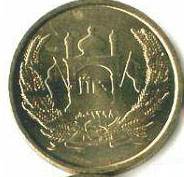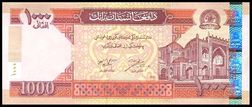|


The Afghani (Pashto/Persian: افغانۍ) (code: AFN) is the currency of Afghanistan. It is subdivided into 100 pul (پول).
First afghani, 1925-2003
The first Afghani (ISO 4217 code: AFA) was introduced in 1925, replacing the Afghan rupee. In addition to being subdivided into 100 pul, 20 Afghani were equal to the amani. The rate of conversion from the rupee is sometimes quoted as 1 Afghani = 1.1 rupee, based on the silver contents of the last rupee coins and the first Afghani coins. The Afghani initially contained 9 grams of silver.
In 1936, the Afghani was pegged at 4 Afghani = 1 Indian rupee. From 1940, the Afghani was pegged to the U.S. dollar at the following rates:
| Pegged value of the first Afghani |
| Date introduced |
Value of U.S. dollar in Afghani |
| 1940 |
13 |
| 1947 |
13.44 |
| 1948 |
14.17 |
| 1949 |
16.8 |
| 1956 |
20 |
| 1963 |
45 |
| 1982 |
50.6 |
Between 1979 and 1982 and again from 1992, the Afghani's value floated.
Prior to the U.S. invasion of Afghanistan, warlords, political parties, foreign powers and forgers each made their own Afghani banknotes, with no regard to standardization or honouring serial numbers. In December 1996, shortly after the Taliban took control of Afghanistan's institutions, Ehsanullah Ehsan, the chairman of the Taliban's Central Bank, declared most Afghani notes in circulation to be worthless (approximately 100 trillion Afghani) and cancelled the contract with the Russian firm that had been printing the currency since 1992. Ehsan accused the firm of sending new shipments of Afghani notes to ousted president Burhanuddin Rabbani in northern Takhar province. The exchange rate at the time of Ehsan's announcement was 21,000 Afghani to the U.S. dollar The Northern Alliance then had banknotes produced in Russia which were sold on the markets of Kabul at half their value.
In April, 2000, the Afghani traded at 6400 AFA per USD. By 2002, the Afghani was valued at 43,000 AFA per USD.
Coins
In 1925, bronze and brass 2, 5 and 10 pul, billon 20 pul, silver ½ and 1 Afghani, and gold ½ and 1 amani coins were introduced, followed by silver 2½ Afghani and gold 2½ amani in 1926. In 1930, bronze and brass 1 and 25 pul were added, along with bronze 3 pul and cupro-nickel 10 and 20 pul in 1937.
In 1952, aluminium 25 pul and nickel-clad-steel 50 pul were introduced, followed by aluminium 2 and 5 Afghani in 1958 and nickel-clad-steel 1, 2 and 5 Afghani in 1963. In 1973, the Republic of Afghanistan issued brass-clad-steel 25 pul, copper-clad-steel 50 pul and cupro-nickel-clad-steel 5 Afghani coins. These were followed, between 1978 and 1980, by issues of the Democratic Republic of Afghanistan consisting of aluminium-bronze 25 and 50 pul and cupro-nickel 1, 2 and 5 Afghani.
Banknotes
Between 1925 and 1928, Treasury notes were introduced in denominations of 5, 10 and 50 Afghani. In 1936, 2, 20 and 100 Afghani notes were added. The Bank of Afghanistan took over paper money production in 1939, issuing notes for 2, 5, 10, 20, 50, 100, 500 and 1000 Afghani. The 2 and 5 Afghani notes were replaced by coins in 1958. In 1993, 5000 and 10,000 Afghani notes were introduced.
Second afghani, 2002-present
Between October 7, 2002, and January 2, 2003, a new Afghani was introduced with the ISO 4217 code AFN. No subdivisions have been issued. It replaced the previous Afghani at two distinct rates. Issues of the government of President Burhanuddin Rabbani were replaced at a rate of 1000 to the new Afghani, whilst the issues of Abdul Rashid Dostum (the Northern Alliance) were replaced at a rate of 2000 to the new Afghani, The new Afghani was valued at 43 Afghani to the U.S. dollar. Prior to the reissue, there were more than 15 trillion Afghani in circulation after unrestrained printing under Taliban rule and during wars and occupation.
After depreciating during the last quarter of 2003/04, the Afghani has been appreciating steadily, gaining 8 percent against the U.S. dollar between end-March 2004 and end-July 2004. This appreciation, at a time of increasing inflation, appears to reflect a greater willingness by the population to use the Afghani as a medium of exchange and as a store of value. This trend appears to be attributable to the relative stability of the exchange rate since the introduction of the new currency, administrative measures aimed at promoting its use, such as the requirement that shopkeepers must price goods in Afghani. Donors are increasingly making payments in Afghani instead of U.S. dollars and this appears to be widely accepted.
On October 1, Afghan Central Bank governor Anwar Ul-Haq Ahadi announced that Afghans should use their own Afghani currency in daily transactions rather than United States dollars or Pakistani rupees.This was in preparation for October 8 when all prices in the Afghan marketplace were to be specified in Afghani.
Coins
In 2005, coins were introduced in denominations of 1, 2 and 5 Afghani
Banknotes
In 2002, banknotes were introduced in denominations of 1, 2, 5, 10, 20, 50, 100, 500 and 1000 Afghani. The 1, 2 and 5 Afghani notes were replaced by coins in 2005.
The text on this page has been made available under the Creative Commons Attribution-ShareAlike License and Creative Commons Licenses
|
